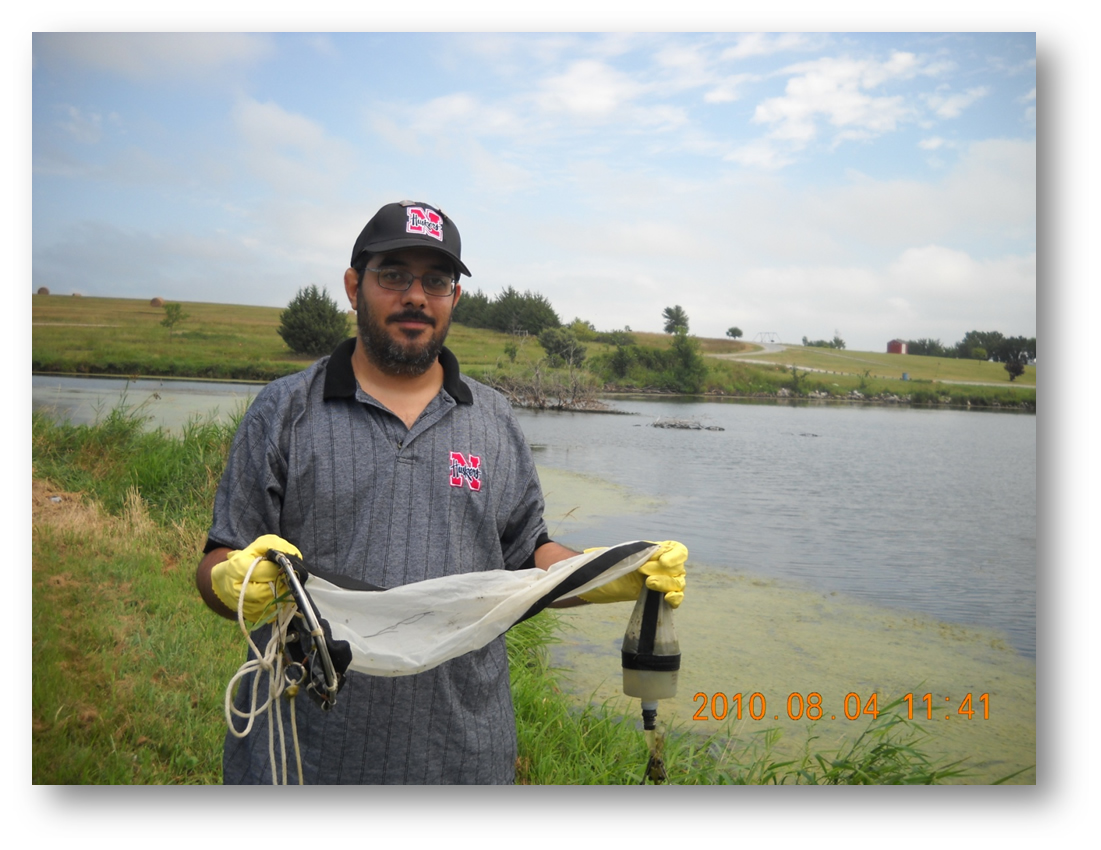
Maitham A. Al-Sammak will soon return to the Middle East, Ph.D. in hand, to apply what he has learned detecting water contaminants in Nebraska to similar issues in other parts of the world.
Al-Sammak worked with Kyle Hoagland, professor of aquatic ecology at SNR, and Dan Snow, director of UNL’s Water Sciences Lab, to complete his degree in Environmental Health, Occupational Health, and Toxicology, a joint program offered by the School of Natural Resources, University of Nebraska-Lincoln, and the University of Nebraska Medical Center in Omaha. His dissertation was on “Occurrence and Effect of Algal Neurotoxins in Nebraska Freshwater Ecosystems.”
Researchers have found that exposure to certain cyanobacteria, in particular a non-protein amino acid called BMAA, may be connected to neurodegenerative conditions such as Lou Gehrig’s disease (ALS), Alzheimer’s, and Parkinson’s in humans.
Al-Sammak is from Iraq, where he was originally trained as a veterinarian. He was teaching at the University of Baghdad when he was nominated to be part of the Iraqi Scholarship Program of the Ministry of Higher Education and Scientific Research, to meet a need for expertise in toxicology and poisonous plants.
The issue also has personal resonance for Al-Sammak, whose last name means “fisherman” in his native Arabic. For generations his family has worked in the fish trade, bringing fish from Iraq southern marshes and rivers to markets in Baghdad. They eat a lot of fish, he explained, and after an uncle died of ALS, Al-Sammak began to think more about the algal blooms he’d seen in the waters.
Now he hopes his research and testing of Nebraska freshwater will keep other people from getting sick.
“At least we will know if BMAA is really found in Nebraska. We will tell people if you go to the lakes, swim, but don’t drink the water and don’t eat the fish.”
The next step after knowing it is there is prevention. People should check the water quality alerts before swimming in lakes.
Al-Sammak’s research investigated how cyano-neurotoxins reach the human nervous system. His hypothesis was that humans can be exposed indirectly, by eating fish or animals that have eaten algae, or by swimming in or drinking from contaminated water.
Al-Sammak, Snow and Hoagland developed a new method – High Performance Liquid Chromatography/Fluorescence Detection -- to detect three contaminants at once: BMAA, DABA and anatoxin-a.
His research took him to 12 lakes in Nebraska, 10 that were known to be contaminated, and two with no history of toxins. His sampling included 248 fish, 72 plants and 67 water samples. He found the neurotoxins in 56 water samples, 30 plant samples, and 57 fish samples. None of the cyano-toxins were present in the control lakes.
Based on these findings, Al-Sammak and his advisors will recommend that the Nebraska Department of Environmental Quality include monitoring for BMAA, DABA and anatoxin-a in its regularly scheduled water monitoring. Though NDEQ is already monitoring for microcystin levels every summer in public lakes throughout the state but does not currently monitor for neurotoxins. Microcystins are another groups of cyanotoxins known to occur regularly in surface water and may cause illness or allergic reactions from recreational exposure.
Al-Sammak’s research is part of a growing body of international, though controversal, research connecting BMAA to neurodegenerative disease. Researchers have looked at human illness as related to BMAA found in wastewater in South Africa, in freshwater in China, in marine water in Sweden, and in desert crust in Qatar.
Perhaps the most famous research on the topic is that of Paul Cox, with the Institute for Ethnomedicine in Jackson, Wyoming. Cox investigated the case of the Chamorro people in Guam, who suffer from exceptionally high incidences of ALS. He found that people received high doses of BMAA through the cycad roots which they grind to make flour used in a tortilla-like bread eaten during holiday celebrations (BMAA is produced by symbiotic cyanobacteria in the roots of the cycad), as well as by eating native fox bats (considered a delicacy, these bats are now nearly extinct), which feed on cycad flowers and seeds, thus concentrating the toxin.
Al-Sammak’s plans for fall 2012 are to work with Cox on a project in the Arabian Gulf nation of Qatar, where they will look for cyanobacteria in samples of sand in an attempt to explain why the high incidences of ALS among some combat troops in the Gulf War, potentially caused by BMAA, does not occur among peoples native to Qatar.
-- Kat Shiffler and Kelly Helm Smith